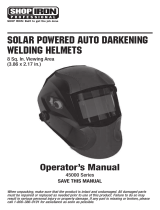4. If you develop momentary eye, nose or throat irritation while operating, this is an
indication that ventilation is not adequate. Stop work and take necessary steps to
improve ventilation in the work area. Do not continue to operate if physical discomfort
persists.
5. Refer to ANSI/ASC Standard Z49.1 for specific ventilation recommendations.
FIRES AND EXPLOSIONS
Heat from flames and arcs can start fires. Hot slag or sparks can also
cause fires and explosions. Therefore:
1. Protect yourself and others from flying sparks and hot metal.
2. Remove all combustible materials well away from the work area or cover the materials
with a protective non-flammable covering. Combustible materials include wood, cloth,
sawdust, liquid and gas fuels, solvents, paints coatings, paper, etc.
3. Hot sparks or hot metal can fall through cracks or crevices in floors or wall openings
and cause a hidden smoldering fire or fires on the floor below. Make certain that such
openings are protected from hot sparks and metal.
4. Do not weld, cut or perform other hot work until the work piece has been completely
cleaned so that there are no substances on the work piece which might produce
flammable or toxic vapors. Do not do hot work on closed containers, they may
explode.
5. Have fire extinguishing equipment handy for instant use, such as a garden hose,
water pail, sand bucket, or portable fire extinguisher. Be sure you are trained in its
use.
6. Do not use equipment beyond its ratings. For example, an overloaded welding cable
can overheat and create a fire hazard.
7. After completing operations, inspect the work area to make certain there are no hot
sparks or hot metal which could cause a fire later. Use fire watchers when necessary.
ESAB has an assortment of welding accessories and personal protection equipment
for purchase. For ordering information contact your local ESAB dealer or visit us on
our website.
CAUTION!
ADDITIONAL SAFETY INFORMATION
For more information on safe practices for electric arc welding and cutting
equipment, ask your supplier for a copy of “Precautions and Safe Practices for
Arc Welding, Cutting and Gouging”, Form 52-529.
The following publications are recommended:
•ANSI/ASC Z49.1 - “Safety in Welding and Cutting”
•AWS C5.5 - “Recommended Practices for Gas Tungsten Arc Welding”
•AWS C5.6 - “Recommended Practices for Gas Metal Arc welding”
•AWS SP - “Safe practices” - Reprint, Welding Handbook
•ANSI/AWS F4.1 - “Recommended Safe Practices for Welding and Cutting of
Containers That Have Held Hazardous Substances”
•OSHA 29 CFR 1910 - "Safety and health standards"
•CSA W117.2 - "Code for safety in welding and cutting"
•NFPA Standard 51B, “Fire Prevention During Welding, Cutting, and Other Hot
Work"
•CGA Standard P-1, “Precautions for Safe Handling of Compressed Gases in
Cylinders”
•ANSI Z87.1, "Occupational and Educational Personal Eye and Face
Protection Devices"

















